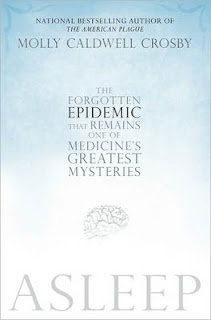Asleep: The Forgotten Epidemic that Remains One of Medicine's Greatest Mysteries
Summary (from the publisher): In 1918, a world war was raging, and a lethal strain of influenza was circling the globe. In the midst of all this death, a bizarre disease appeared in Europe. Eventually known as encephalitis lethargica, or sleeping sickness, it would spread across the world, leaving millions dead or locked in institutions.
Asleep, set in 1920s and '30s New York, follows a group of neurologists through hospitals and insane asylums as they try to solve this worldwide epidemic.
The symptoms could include not only unending sleep but dangerous insomnia, facial tics, catatonia, Parkinson's, and even violent insanity. Molly Caldwell Crosby, acclaimed author of The American Plague, explores the frightening history of this forgotten disease- and details the frantic effort to conquer it before it strikes again.
Review: Asleep details the mysterious and alarming sleeping sickness that swept across the globe in the early twentieth century, and which still pops up in isolated cases today. Encepahlitis Lethargica kills 1/3 of its victims who never wake up, and permanently alters/led to the institutionalization of another third. Yet it remains a mystery, and a largely unknown one at that.
Unlike many dry non-fiction (I'm looking at you, The Emperor of All Maladies), this was an easy read. Part of that was due to the structure which was centered around different patients suffering from encephalitis lethargica and their physicians. However, I found the intentionally narrative-like intro to each chapter a bit heavy handed. For example, "Jelliffe and Tilney sat in the deep red, velvet chairs of the auditorium. Outside, it was cold, and frost powdered the front steps of the building of the New York Academy of Medicine. Across the street, in the early moonlight, the tree branches of Central Park reached like talons toward the nighttime sky." While it certainly made the text less dry, the style was almost too fiction-like for me. I can't help thinking that more non-fiction seems to be leaning towards more of a narrative feel since the popularity of The Devil in the White City. This is certainly not a bad thing, in my opinion.
This disease truly disturbed me. The fact that patients who recovered reported that they were lucid during their catatonic-like state horrified me, in much the same way as the plight of stroke victim condemned to only being able to move one eye in The Diving Bell and the Butterfly. Additionally, I was appalled by the multiple cases of severely altered personalities in those that recovered. Especially that of Rosie, who not only ripped her own teeth out, but tore both of her eyes out with her fingers. Holy mother...That ain't right. Somebody needs to get researching this disease yesterday.
Yet perhaps most mysterious is that despite the fact that millions suffered from encepahlitis lethargica, no one today knows about or discusses the epidemic. As the author quotes Oliver Sacks, "such forgettings are as dangerous as they are mysterious." Why was this disease forgotten?
I have quite a taste for bizarre and unusual medical accounts, so this book was perfect for me. I do wish the book could have offered more of an actual medical account of the source of the disease rather than just case stories, however, I understand that that is largely dependent on the medical knowledge available to the writer. Perhaps more than any other non-fiction books I've read, this book really reminded me of another largely forgotten and greatly unknown plague detailed in The Dancing Plague: The Strange, True Story of an Extraordinary Illness. There are crazy things that can happen to your body out there. Including falling asleep for months or dancing until you collapse dead. Everyone beware.
Stars: 4



Comments
Post a Comment